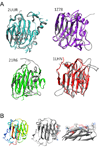Proteomic analysis of Col11a1-associated protein complexes
- PMID: 22038862
- PMCID: PMC3463621
- DOI: 10.1002/pmic.201100058
Proteomic analysis of Col11a1-associated protein complexes
Abstract
Cartilage plays an essential role during skeletal development within the growth plate and in articular joint function. Interactions between the collagen fibrils and other extracellular matrix molecules maintain structural integrity of cartilage, orchestrate complex dynamic events during embryonic development, and help to regulate fibrillogenesis. To increase our understanding of these events, affinity chromatography and liquid chromatography/tandem mass spectrometry were used to identify proteins that interact with the collagen fibril surface via the amino terminal domain of collagen α1(XI) a protein domain that is displayed at the surface of heterotypic collagen fibrils of cartilage. Proteins extracted from fetal bovine cartilage using homogenization in high ionic strength buffer were selected based on affinity for the amino terminal noncollagenous domain of collagen α1(XI). MS was used to determine the amino acid sequence of tryptic fragments for protein identification. Extracellular matrix molecules and cellular proteins that were identified as interacting with the amino terminal domain of collagen α1(XI) directly or indirectly, included proteoglycans, collagens, and matricellular molecules, some of which also play a role in fibrillogenesis, while others are known to function in the maintenance of tissue integrity. Characterization of these molecular interactions will provide a more thorough understanding of how the extracellular matrix molecules of cartilage interact and what role collagen XI plays in the process of fibrillogenesis and maintenance of tissue integrity. Such information will aid tissue engineering and cartilage regeneration efforts to treat cartilage tissue damage and degeneration.
Copyright © 2011 WILEY-VCH Verlag GmbH & Co. KGaA, Weinheim.
Conflict of interest statement
Authors have no declared financial or commercial conflicts of interest.
Figures







Similar articles
-
Isoform-specific heparan sulfate binding within the amino-terminal noncollagenous domain of collagen alpha1(XI).J Biol Chem. 2006 Dec 22;281(51):39507-16. doi: 10.1074/jbc.M608551200. Epub 2006 Oct 24. J Biol Chem. 2006. PMID: 17062562 Free PMC article.
-
Expression, purification, and refolding of recombinant collagen alpha1(XI) amino terminal domain splice variants.Protein Expr Purif. 2007 Apr;52(2):403-9. doi: 10.1016/j.pep.2006.10.016. Epub 2006 Nov 1. Protein Expr Purif. 2007. PMID: 17166742 Free PMC article.
-
Differences in chain usage and cross-linking specificities of cartilage type V/XI collagen isoforms with age and tissue.J Biol Chem. 2009 Feb 27;284(9):5539-45. doi: 10.1074/jbc.M806369200. Epub 2008 Dec 22. J Biol Chem. 2009. PMID: 19103590 Free PMC article.
-
The collagens of articular cartilage.Semin Arthritis Rheum. 1991 Dec;21(3 Suppl 2):2-11. doi: 10.1016/0049-0172(91)90035-x. Semin Arthritis Rheum. 1991. PMID: 1796302 Review.
-
Fell-Muir Lecture: Proteoglycans and more--from molecules to biology.Int J Exp Pathol. 2009 Dec;90(6):575-86. doi: 10.1111/j.1365-2613.2009.00695.x. Int J Exp Pathol. 2009. PMID: 19958398 Free PMC article. Review.
Cited by
-
LRP receptors in chondrocytes are modulated by simulated microgravity and cyclic hydrostatic pressure.PLoS One. 2019 Oct 4;14(10):e0223245. doi: 10.1371/journal.pone.0223245. eCollection 2019. PLoS One. 2019. PMID: 31584963 Free PMC article.
-
Endoplasmic Reticulum Stress and Unfolded Protein Response in Cartilage Pathophysiology; Contributing Factors to Apoptosis and Osteoarthritis.Int J Mol Sci. 2017 Mar 20;18(3):665. doi: 10.3390/ijms18030665. Int J Mol Sci. 2017. PMID: 28335520 Free PMC article. Review.
-
A repeated triple lysine motif anchors complexes containing bone sialoprotein and the type XI collagen A1 chain involved in bone mineralization.J Biol Chem. 2021 Jan-Jun;296:100436. doi: 10.1016/j.jbc.2021.100436. Epub 2021 Feb 19. J Biol Chem. 2021. PMID: 33610546 Free PMC article.
-
Cancer Extracellular Matrix Proteins Regulate Tumour Immunity.Cancers (Basel). 2020 Nov 11;12(11):3331. doi: 10.3390/cancers12113331. Cancers (Basel). 2020. PMID: 33187209 Free PMC article. Review.
-
Tumor matrix protein collagen XIα1 in cancer.Cancer Lett. 2015 Feb 28;357(2):448-53. doi: 10.1016/j.canlet.2014.12.011. Epub 2014 Dec 12. Cancer Lett. 2015. PMID: 25511741 Free PMC article. Review.
References
-
- Pogue R, Sebald E, King L, Kronstadt E, et al. A transcriptional profile of human fetal cartilage. Matrix Biology. 2004;23:299–307. - PubMed
-
- Poole CA. In: Joint Cartilage Degradation; Basic and Clinical Aspects. Woessner JF, Howell DS, editors. New York: Marcell Dekker; 1993.
-
- Wight TN, Heinegard DK, Hascall VC. In: Cell Biology of the Extracellular Matrix. Hay ED, editor. New York: Plenum; 1991. pp. 45–78.
-
- Hardingham TE, Venn G. Chondrotin sulphate/dermatan sulfate proteoglycans in cartilage: aggrecan, decorin and biglycan. In: Scott JE, editor. Dermatan Sulfate Proteoglycans: Chemistry, Biology, Chemical Pathology. London, England: Portans Press; 1993. pp. 207–217.
-
- Burgeson RE, Hollister DW. Collagen heterogeneity in human cartilage: identification of several new collagen chains. Biochem. Biophys. Res. Com. 1979;87:1124–1131. - PubMed
Publication types
MeSH terms
Substances
Grants and funding
LinkOut - more resources
Full Text Sources
Molecular Biology Databases
Miscellaneous

